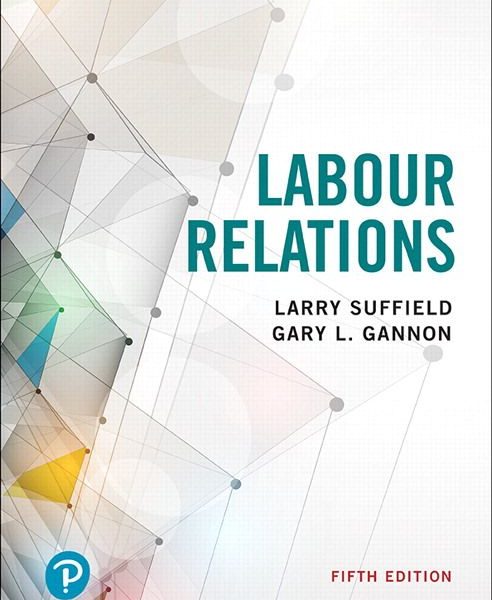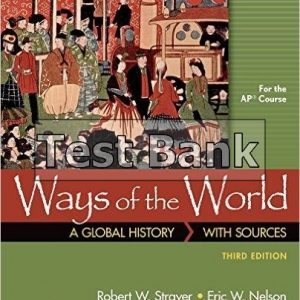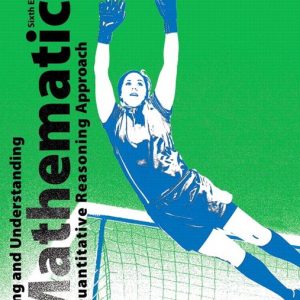Instant download Test Bank for Labour Relations 5th by Suffield pdf docx epub after payment.

Product details:
- ISBN-10 : 0199049319
- ISBN-13 : 978-0199049318
- Author: Hanneli Bendeman; Bronwyn Dworzanowski-Venter; Robert Venter; Andrew Levy
Labour Relations in South Africa provides a thorough and engaging introduction to the science and practice of labour relations in South Africa. The fifth edition presents a more critical and reflective approach, engaging with the various issues, shifts, and seismic events that have impacted this dynamic field in recent years. The text has been expanded to encompass a multifaceted perspective relating to business, science, law, economics, and sociology, and to focus more specifically on the context and dynamics of a developing country.
Table of contents:
- 1 Introduction to Labour Relations
- Defining Labour Relations, Industrial Relations and Employee Relations
- HRM Professionals and Labour Relations
- Labour Relations Issue 1-1 Labour Relations Questions
- The Employment Relationship in Non-union and Union Settings
- The Employment Relationship
- Key Considerations 1-1 Non-union vs. Unionized Workplaces
- The Development of Unions and Labour Relations in Canada
- Key Considerations 1-2 Events in the Development of Labour Relations
- Early Unions
- Entry and Influence of International Unions
- Early Labour Legislation and the Rise of Industrial Unions
- Public-Sector Unionization
- Frameworks for Labour Relations
- Industrial Relations Systems Approach—John Dunlop
- Key Considerations 1-3 Elements of Dunlop’s IR Systems Model
- “Open-system” Industrial Relations—Alton Craig
- Political Economy Approach
- Overview of This Book
- 2 The Environment
- Economic Environment
- Macroeconomic Environment
- Government Economic Policy
- Industry and Firm-Level Demand
- Other Economic Trends Affecting Labour Relations
- Technology
- Demographics
- Social Environment
- Political Environment
- Labour Relations Issue 2-1 What Are Your Values and Beliefs Relating to Unions?
- Divided Jurisdiction
- Legal Environment
- Human Rights Legislation
- Key Considerations 2-1 Possible Measures to Accommodate
- Key Considerations 2-2 Factors Determining Undue Hardship
- Labour Relations Issue 2-2 When Is a Discriminatory Requirement a BFOR?
- The Canadian Charter of Rights and Freedoms
- 3 Employers: Objectives, Processes and Strategy
- Management Objectives and Processes
- Efficiency or Productivity
- Control
- Employer Labour Relations Strategy
- Factors Affecting an Employer’s Labour Relations Strategy
- Possible Employer Strategies
- Strategies of Canadian Employers
- Importance of Labour Relations Strategy
- Alternative HR Strategies or Approaches to HR Management
- High-Performance Work Systems
- Key Considerations 3-1 Policies and Practices for a High-Performance Work System
- Employee Relations Programs
- Employee Communications
- Key Considerations 3-2 Best Practices in Employee Communications
- Staff Recognition Programs
- Employee Involvement
- Forms of Employee Involvement
- Employee Involvement Under the Collective Agreement
- Employee Involvement Outside of the Collective Agreement
- Labour Relations Issue 3-1 Employee Involvement – Joint Union–Management Committees
- Further Considerations for Employee Involvement Programs
- Outcomes of Employee Involvement
- Key Considerations 3-3 A Progressive Discipline Framework
- Diversity Management
- 4 Unions: Objectives, Processes and Structure
- Unions in Canada
- Extent of Unionization
- Types of Unions
- Union Objectives and Processes
- Improving Terms and Conditions of Work
- Protecting Employees Against Arbitrary Management Action
- Providing a Process for Conflict Resolution and Employee Input
- Pursuing Economic and Social Change
- Union Structure and Functions
- Union Local
- Key Considerations 4-1 Functions of a Union Local
- Independent Local Unions
- National and International Unions
- Key Considerations 4-2 Functions of National and International Unions
- Labour Relations Issue 4-1 The Relationship Between a National Union, Union Local and Union Members
- Labour Federations and Congresses
- Key Considerations 4-3 Functions of the Canadian Labour Congress
- Labour Relations Issue 4-2 Unifor Splits from Canadian Labour Congress
- Labour Councils
- Other Features of Union Structure
- 5 Governments, Labour Relations Boards and Other Parties
- Government Objectives and Processes
- Regulation of Labour Relations Processes
- Regulation of Labour Relations Outcomes
- Protection of the Public Interest
- Regulation of the Economy
- Assistance to Industry
- Regulating Market Practices and Results
- Government Employers: Objectives
- Maintaining Office
- Labour Relations Boards
- Composition of Labour Relations Boards
- Key Considerations 5-1 Labour Relations Board Responsibilities
- Board Responsibilities
- Procedure and Remedies
- Labour Relations Issue 5-1 Labour Relations Boards: Part of a Tri-Partite Employment Relationship
- Other Parties
- Arbitrators
- Courts
- Human Rights Tribunals
- 6 Union Organizing Drive and Certification
- The Decision to Unionize
- Why Employees Unionize
- Why Employees Do Not Join a Union
- External Factors Affecting Unionization
- How Bargaining Rights Are Obtained and Their Significance
- Certification of a Union
- Organizing Campaign
- Application for Certification to Labour Relations Board
- Labour Relations Issue 6-1 Determining Employee Status: The Fourfold Test
- Determination of Union Support
- Conduct During Organizing and Certification Processes
- Employer Unfair Labour Practices
- Key Considerations 6-1 Employer Unfair Labour Practices
- Permissible Employer Conduct
- Key Considerations 6-2 Permitted Employer Conduct During an Organizing Campaign
- Labour Relations Issue 6-2 What Employers Have Said in Response to a Union Organizing Campaign
- Union Unfair Labour Practices
- Remedies for Unfair Labour Practices
- Decertification
- Decertification Application by Employees
- Certification of a Different Union
- Additional Grounds for Decertification
- Successor Rights
- 7 The Collective Agreement
- Introduction
- Collective Agreement Contents
- Legal Requirements for Collective Agreements
- Mandatory Terms
- Union Recognition
- Key Considerations 7-1 Union Recognition
- Grievance and Arbitration Process
- Key Considerations 7-2 Grievance and Arbitration Procedure
- Strikes and Lockouts
- Duration or Term of the Agreement
- Voluntary Terms
- Management Rights
- Labour Relations Issue 7-1 Does Management Have to Act Reasonably?
- Bargaining Unit Work
- Union Security
- Key Considerations 7-3 Protection of Bargaining Unit Work
- Key Considerations 7-4 Union Security
- Labour Relations Issue 7-2 Can the Collective Agreement Prevent Probationary Employees from Challeng
- Seniority
- Key Considerations 7-5 Seniority Definition, Establishment and Termination
- Labour Relations Issue 7-3 Seniority Accumulation Protection During Disability and Pregnancy & Paren
- Seniority: Application to Layoffs, Recalls and Job Vacancies
- Key Considerations 7-6 Seniority Application to Layoffs, Recalls and Job Vacancies
- Key Considerations 7-7 Discipline and Discharge
- Discipline and Discharge
- Hours of Work and Scheduling
- Key Considerations 7-8 Hours of Work and Scheduling
- Overtime
- Key Considerations 7-9 Overtime
- Public Holidays
- Vacation
People also search:
Labour Relations 5th edition
Labour Relations 5th edition pdf
Labour Relations
employment and labour relations act
labour relations act summary pdf
alberta labour relations board rules of procedure





